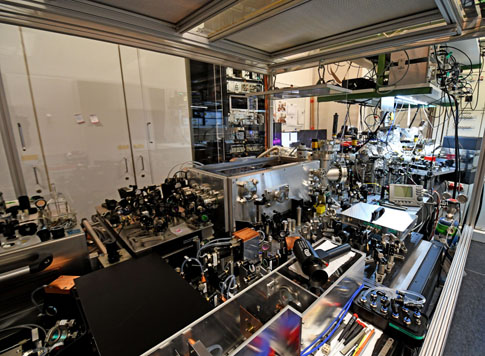
Frequency combs in the Extreme Ultraviolet (XUV)
Femtosecond laser optical frequency combs have revolutionized the measurement of optical frequencies and enabled optical atomic clocks. The same comb techniques are employed to control the carrier-envelope phase and thus the waveform of ultrafast laser pulses, which has led to the generation of single attosecond pulses. We hope that intracavity high harmonic generation (HHG) will open the door to another promising joint frontier of precision spectroscopy and ultrafast science. We are generating coherent radiation in the extreme ultraviolet (XUV) by high harmonic generation at the full oscillator repetition frequency of 10-100 MHz which is up to a 1000 times faster than previously possible with chirped pulse amplification or regenerative amplifiers. This high repetition rate causes the modes of the resulting XUV frequency comb to be well separated, allowing high resolution laser spectroscopy in this spectral region for the first time.
Intra-Cavity High Harmonic Generation (HHG)
We couple the pulses from a femtosecond mode-locked laser into a
high finesse optical resonator that contains a Xenon gas jet at the cavity focus
as the nonlinear medium. Inside this resonator, the pulse energy is enhanced so
that it can drive the nonlinear process (HHG). For cw lasers, enhancement factors
exceeding 100,000 have been reached and overall nonlinear conversion efficiencies
approaching unity can be achieved. In the case of a mode-locked ultrafast laser,
however, complying with the following extra requirements is more difficult: The
output spectrum of a mode-locked laser does not contain just a single cw mode
but a comb of such modes. An optical resonator for such radiation has to be
simultaneously resonant for each mode. This can be accomplished with a resonator
of appropriate length and zero group velocity dispersion (GVD). Thus far we have
managed to extract microWatts of XUV power which could be sufficient to
drive the 1S-2S transition in a hydrogen-like Helium ion with a reasonable
rate (~1 Hz) provided that this power can be delivered and focused onto the
ion which is difficult to do without significant losses.
XUV frequency comb generator with ion trap

Current Members
Johannes Weitenberg, Akira Ozawa, Fabian Schmid, Thomas Udem
Former Members
Andreas Vernaleken, Tobias Lamour, Peter Šušnjar, Christoph Gohle, Birgitta Bernhardt, Christian Speck
If you are considering joining our team as a Bachelor, Master or PhD student, or as a Postdoc, please email to: Thomas Udem
Further Reading
Fabian Schmid, Johannes Weitenberg, Theodor W. Hänsch, Thomas Udem and Akira Ozawa,
Simple Phase Noise Measurement Scheme for Cavity-stabilized Laser Systems,
Opt. Lett. 44, 2709 (2019)
Byoung-moo Ann, Fabian Schmid, Jonas Krause, Theodor W. Hänsch, Thomas Udem and Akira Ozawa,
Motional Resonances of three-Dimensional dual-Species Coulomb Crystals,
J. Phys. B 52, 035002 (2019)
Akira Ozawa, Josue Davila-Rodriguez, Theodor W. Hänsch and Thomas Udem,
Quantum Zeno Effect assisted Spectroscopy of a single trapped Ion
Scientific Reports, 8, 1064314 (2018)
Johannes Weitenberg, Andreas Vernaleken, Jan Schulte, Akira Ozawa, Thomas Sartorius,
Vladimir Pervak, Hans-Dieter Hoffmann, Thomas Udem, Peter Russbüldt, and Theodor W. Hänsch,
Multi-Pass-Cell-based nonlinear Pulse Compression to 115 fs at 7.5 µJ pulse Energy and 300 W Average Power,
Opt. Expr. 25, 20502 (2017)
Akira Ozawa, Josue Davila-Rodriguez James R. Bounds, Hans A. Schuessler, Theodor W. Hänsch, and Thomas Udem,
Single Ion Fluorescence excited with a single Mode of an UV Frequency Comb,
Nat. Commun. 8, 44 (2017)
